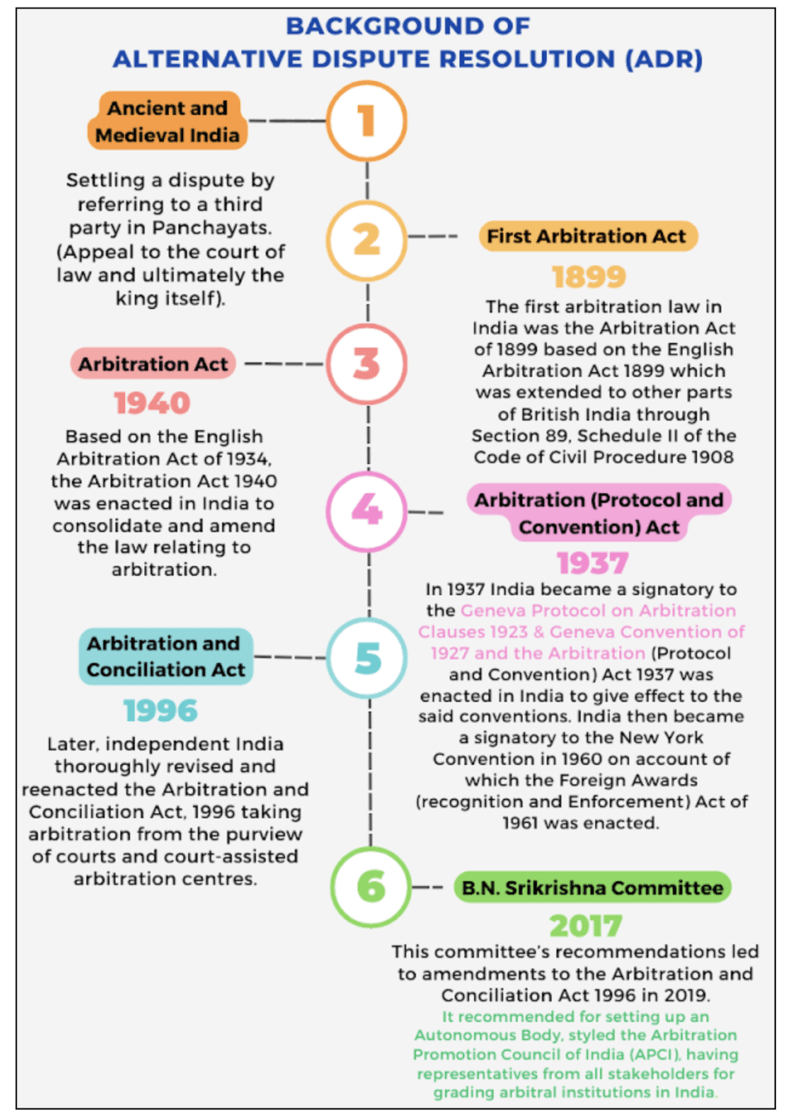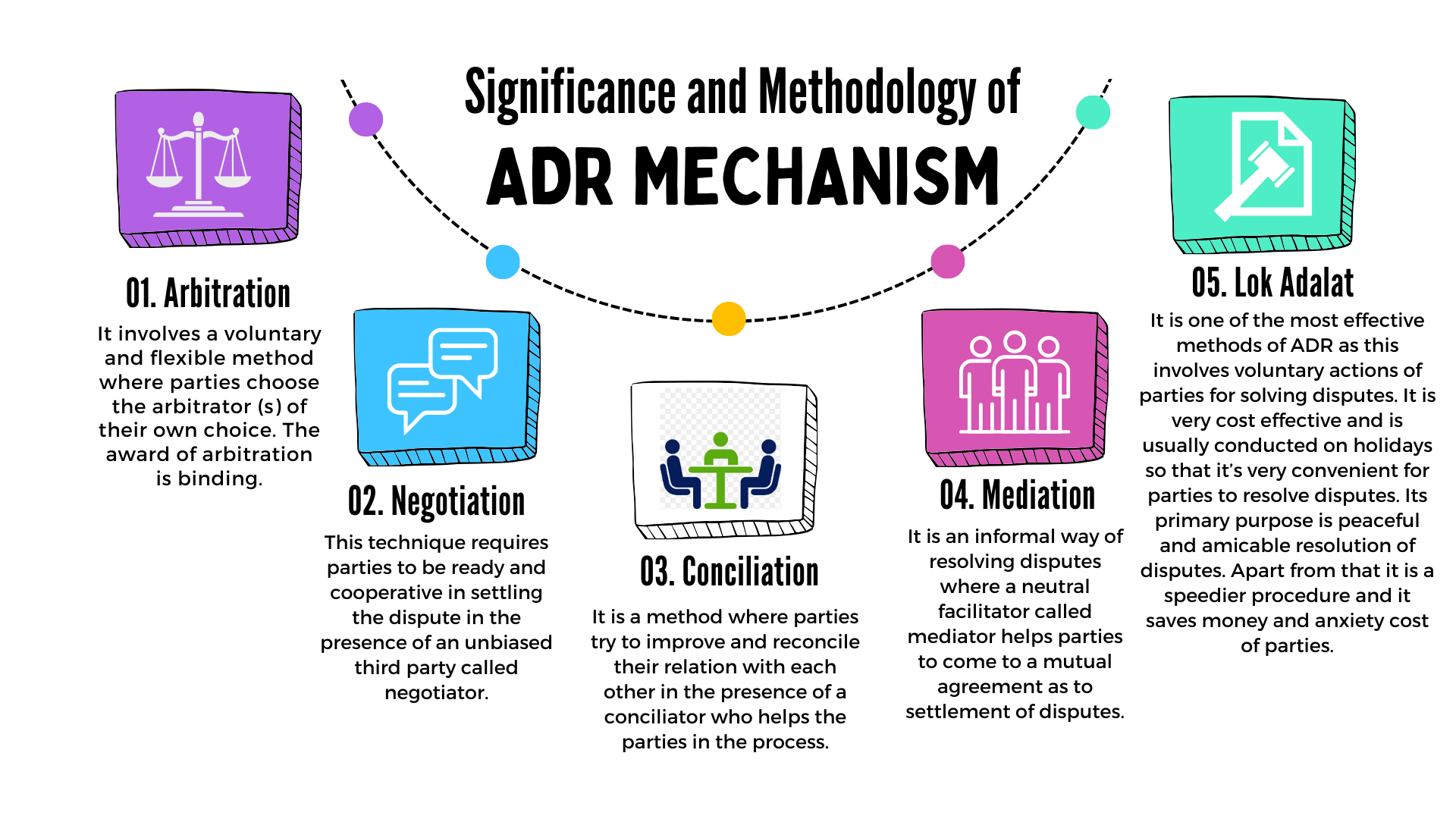Whither Arbitration
“At all events, arbitration is more rational, just, and humane than the resort to the sword.” - Richard Cobden
Relevance: GS II (Polity)
- Prelims: Alternative Dispute Resolution (ADR) in India;
- Mains: Judiciary; Interpretation and Arbitration in India – (Issues associated);
Why in the News?
There is a dearth of information relating to caseload and functioning; particularly in the case of arbitration centers associated with trade and merchant associations and city-specific chambers of commerce.

Why Efficient Arbitration is needed in India?
- Need in the MSMEs sector: Micro Small and Medium Enterprises (MSMEs) are eagerly awaiting the establishment of arbitration institutions and their designation by the high courts in the country.
- Under Section 18(3) of the MSME Act 2006, when a dispute of MSMEs fails to settle through conciliation, the MSME Council shall either take up the dispute itself for arbitration or refer it to an arbitration institution for settlement.
- The institution then conducts arbitral proceedings and passes an award that is binding on the disputing parties and equivalent to a court’s decree.
- They are institutionally stable: Arbitrations if conducted in a tight environment, under the institution’s rules, and if supervised are responsible for various aspects relating to arbitral tribunal composition, administrative, financial, and legal matters and ensuring the quality of an award passed by their panel arbitrator.
- Need for a speedy Justice Delivery System: Delivering justice is the greatest challenge before the Indian judicial system.
- The increasing burden of over 4.9 crore pending cases in Indian courts prompted policymakers to consider strengthening ADR mechanisms.
- The problem has escalated to such an alarming proportion that unless it is solved speedily and effectively, it will, shortly, completely crush the whole edifice of our judicial system.
- Need to increase expertise in Judiciary: The number of judges in India is comparatively low considering the ratio of population in India.
- Need for a rights-based approach to justice delivery: The complex nature of the laws and rigidity of courts further amplify the need for an alternate mechanism to settle disputes.
- In the Food Corporation of India Vs Joginderpal case, the Supreme Court observed that “the law of arbitration must be ‘simple, less technical and more responsible to the actual reality of the situations’, ‘responsive to the canons of justice and fair play’.
- The absence of procedure and unnecessary formalities makes the judicial process of arbitration hassle-free. Further, at present there is no fixed time given in the law for the speedy disposal of cases.
- The parties dissatisfied with an arbitrator’s award may petition a court under section 34 of the Act within 90 days to set aside the award.

Major Institutional Challenges in India:
- Unawareness in Public: The lack of legal education in the larger strata of our society is one of the greatest hindrances in the growth of ADR in India.
- People need to be made aware that court intervention is not required for the appointment of an Arbitrator. Likewise, many are unaware that the Arbitrators’ award is binding.
- Execution Issues:
- Ignorance: Certain government officials, and bankers, are ignorant that an arbitration award by a party-appointed Arbitrator is equivalent to a court decree.
- Section 11(3A) of the Act seeks that High Courts and the Supreme Court designate arbitration institutions, which is still a non-starter. There are numerous instances of these officers mocking the institutional arbitrators’ awards.
- The Arbitration Council of India to authorize and regulate Arbitration Institutions (passed in 2021) has yet to be established. It is still in the stage of developing work procedures, rules, and regulations.
- Non-clarity of proceedings and dearth of Data: In the present ADR mechanism there is no established method for execution. The parties are now again in the same litigation process which was meant to be bypassed by ADR. Several arbitral institutions do not have websites.
- Lack of professionals and skilled lawyers: Due to the generalized theoretical system of Judicial education present in India, we lack skilled arbitrators and legal professionals. A large number of cases remain unfruitful in ADR settlement due to this.
Way Forward:
- Need to Democratize Judiciary: There is an urgent need for the Centre and all the High Courts in the country to take note of the institutions operating in each state and designate them as arbitration institutions to alleviate the much-discussed burden on courts.
- There is a huge need to build ADR tribunals in every district of the states to make it more accessible to every citizen of India.
- Bringing Behavioral changes: Legally educating the lower strata of society needs to be a part of school and college curriculums.
- Further, legal professionals must be upskilled and provided with further career opportunities in ADR solutions to enhance the execution mechanism.
Conclusion: The need for better conflict resolution methods is urgent in today’s world of globalization and technology. Due to the urgency of today’s world, developed nations already favor these approaches for resolving disputes. Our government must see this need (much awaited Arbitration Council of India) and address the drawbacks and difficulties of ADR as soon as possible constructively and more efficiently.
Mains PYQs
Q. What are the major changes brought in the Arbitration and Conciliation Act, of 1966 through the recent ordinance promulgated by the President? How far will it improve India’s dispute resolution mechanism? Discuss. (UPSC 2015)
Q. Khap panchayats have been in the news for functioning as extra–constitutional authorities, often delivering pronouncements amounting to human right violations. Discuss critically the actions taken by the legislative, executive and judiciary to set the things right in this regard. (UPSC 2015)

